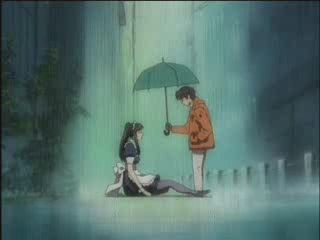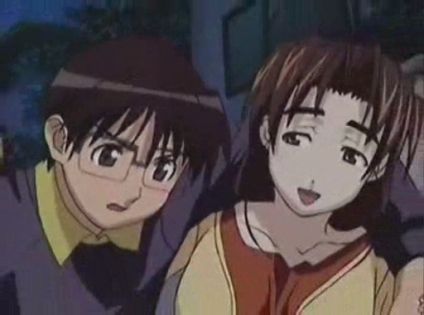22 May 2010: Love Hina and its place in anime history

At least there's no spinning watermark.
Although I own all the DVDs, I chose to re-watch my archive of Love Hina fansubs over the past few months. As you might expect, the video and audio quality is atrocious by modern standards, with 320x240 15fps encodes being the norm. (The entire season fits on two CD-Rs.) Depending on the group, the subtitles themselves can also be quite poor by today's standards. Many lines are poorly timed and some episodes were clearly finished by non-native English speakers. Every single episode was generally inferior from a technical perspective than the samples in my recent Chu-Bra!! PSP experiment. Nevertheless, Love Hina in this crude form invokes a certain nostalgia when remembering the brief, recent history of anime distribution in America.

Try a little tenderness, Keitaro.
Love Hina was one of the first shows successfully distributed widely in entirely digital formats. Although the initial rips came from analog broadcasts, the Internet (and sneakernet) distribution of Love Hina episodes was accomplished digitally. Heretofore, American anime fans typically purchased, traded, or copied videotapes of fansubs. This is how I first watched All Purpose Cultural Cat Girl Nuku Nuku, for example. For those unfamiliar with the medium, videotapes are purely analog, so the quality degrades significantly after each generation. If you were lucky, you got to watch something that was low enough on the copy-of-a-copy-of-a-copy chain that it did not look like mush.

Aneue > Onee-sama.
What a long way we've come in merely a decade. Fansubs today appear with soft-subs that can be turned off and video quality that surpasses DVD limitations by a large margin. No wonder the anime DVD bubble collapsed so quickly. I, like many buyers, contracted my buying habits once DVDs became clearly inferior to recordings of initial broadcasts—waiting for Blu-ray releases. I'm still waiting. FUNimation is taking cautious steps, but I won't be cajoled long by lackluster upscales.

Keitaro's dilemma at the end of Love Hina is not
unlike Shinji's struggle with Instrumentality.
So what about Love Hina itself? Many former fans have recanted their affection for the title, disclaiming, "I hadn't seen much anime at that time, so I didn't know better." I still find Love Hina as charming and funny as ever. It balances a winning combination of absurd mechanized turtles and emotional resonance. It's a relic from a time of the big-boobed tsundere (before the stereotype turned into a complete joke), to be sure, and its harem comedy roots were unoriginal even then, but its cast remains engaging. Megumi Hayashibara is still absolutely dead-on as Aunt Haruka, and a round or two with Motoko reminds me how sorely Asakawa Yuu is missed. Likewise, the motif about promises still rings true today; it carries more import than the typical canned motivations anime characters generally spout. And perhaps it also implores viewers to remember a past they once loved and should not forget.


